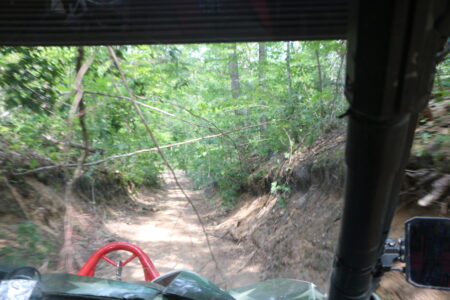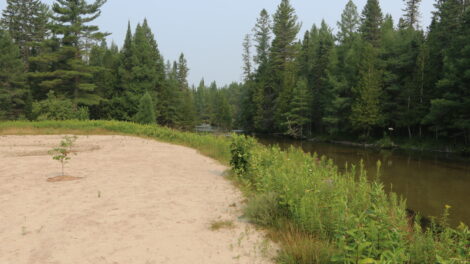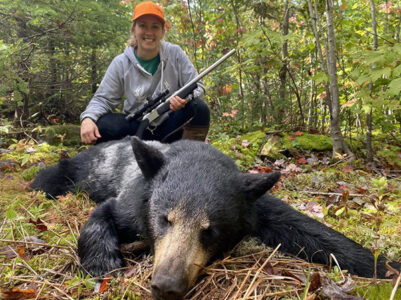Off-trail ORVs destroy Michigan ecosystems and the DNR can’t keep up
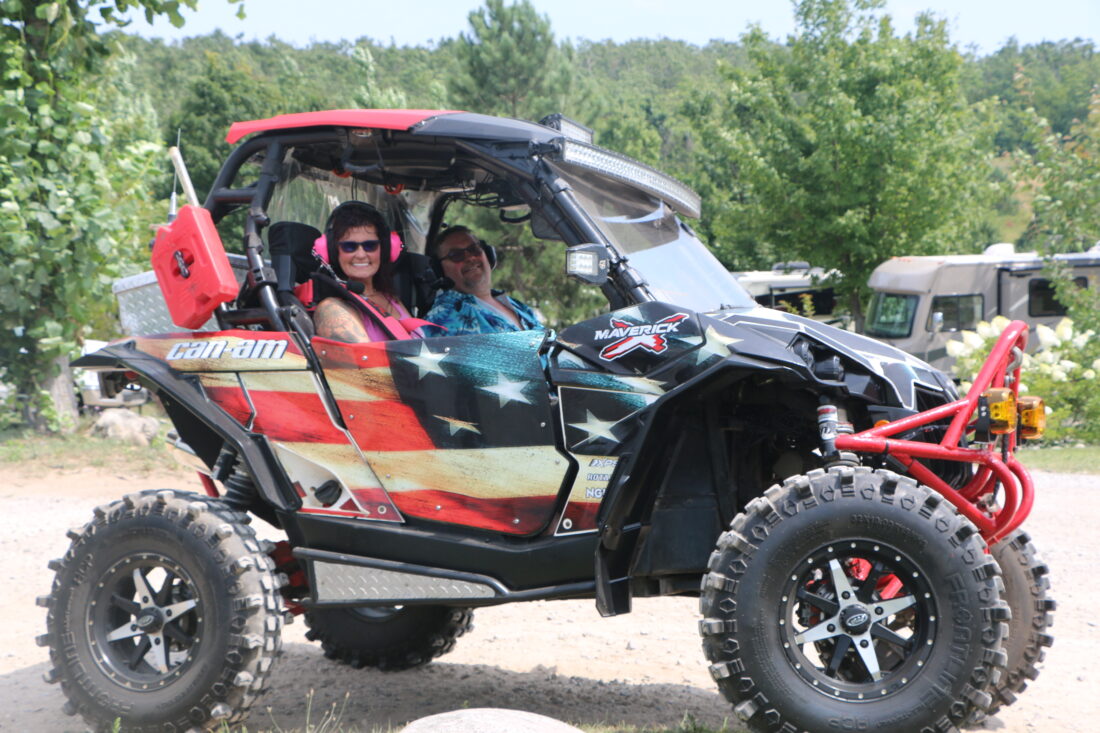
Courtesy Photo Tammie and Mark Furgeson smile in their side-by-side at Chandler Hill Campground in Boyne Falls. (Austin Rowlader/Northern Michigan Journalism Collaborative)
With almost 300,000 off-road vehicles hitting northern Michigan trails every year, Michigan’s state forests are reaching a breaking point.
When the Legislature opened state forest lands in northern Michigan to ORVs in 2018, lawmakers did so without providing new money to repair the damage the vehicles can cause — especially when they go off-trail.
“We’re hitting the worst-case scenario,” said John Davis, forest fire officer for the Michigan Department of Natural Resources field office in Bellaire.
The destruction from ORVs is spread across state forest lands in northern Michigan and the Upper Peninsula, but even the DNR may not have a full grasp of the damage. According to a recent auditproperly document inspections of the state forest trail system.
The DNR had about $1.5 million from ORV license and permit sales to repair off-trail damage, but DNR officials said that barely scratches the surface of all the repairs needed after the increasingly powerful vehicles tear a new path in the forest.
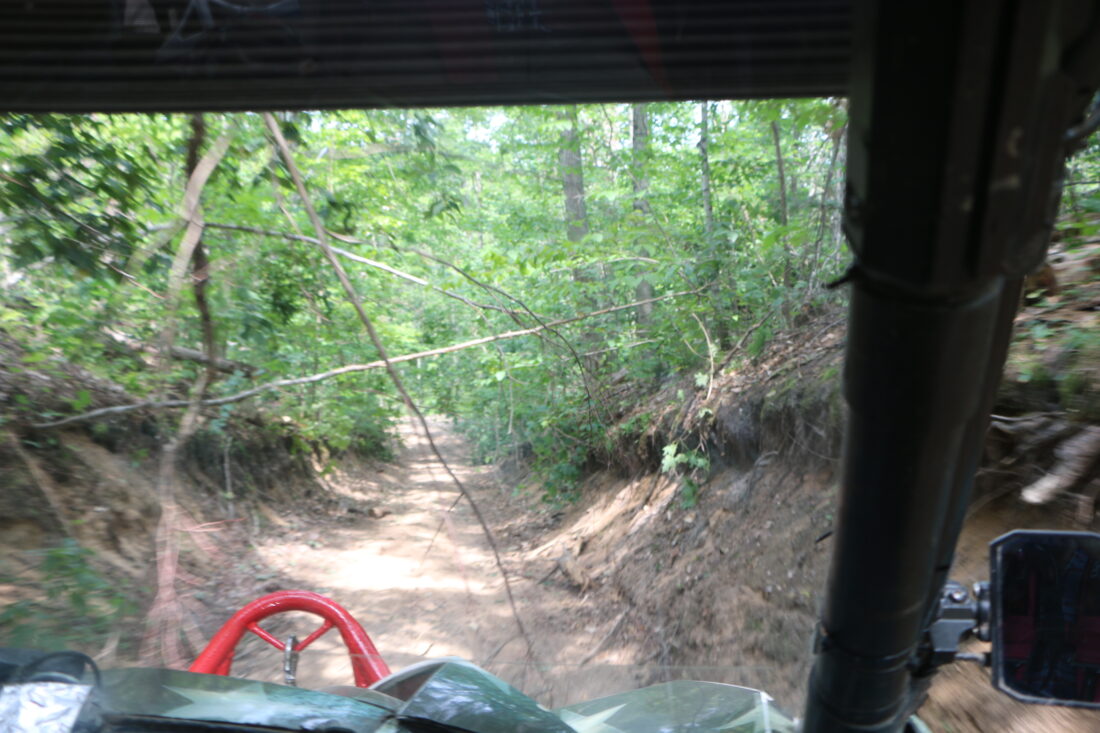
Courtesy Photo Erosion is seen on the banks of a path on state forest land from the passenger’s seat of Mark and Tammie Furgeson’s side-by-side. The erosion is likely the result of years of off-road vehicle use. (Austin Rowlader/Northern Michigan Journalism Collaborative)
Davis’s office received about $5,000 this year to repair ORV damage.
“We’re understaffed and we don’t have a lot of money,” he said. “So we’re trying to do the best we can.”
He thought there could be “a completely separate division (of the DNR) for restoration and remediation of the environment … people could have work for years.”
‘There won’t be anything left’
Davis said the main threat to state forest lands is ORV riders leaving the designated trail system and blazing trails of their own.
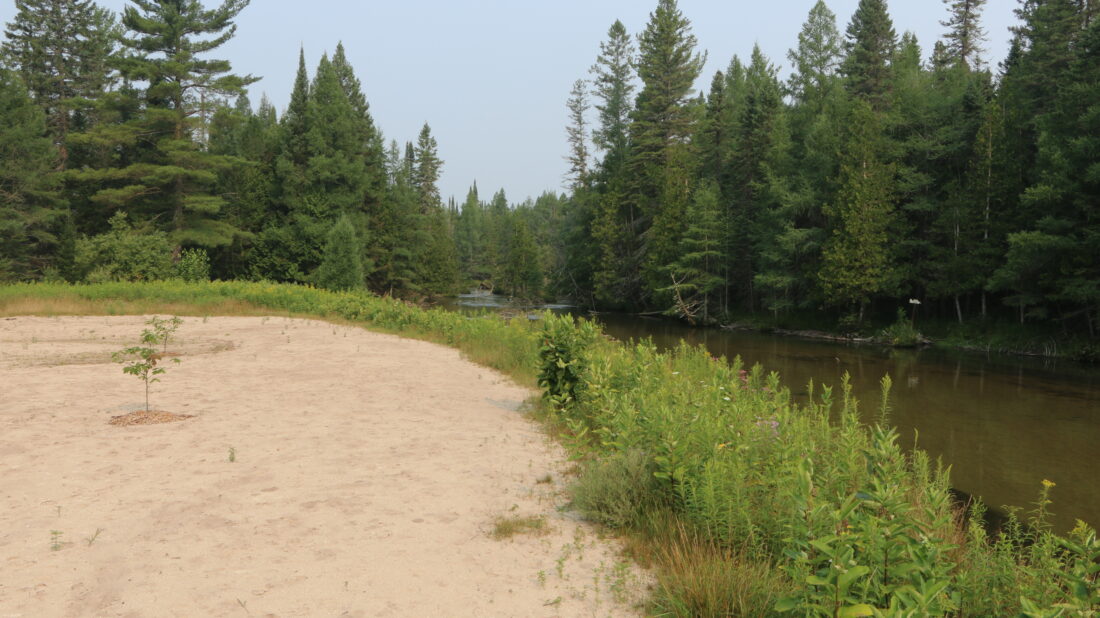
Courtesy Photo The Jordan River ecosystem is seen one year after John Davis and Michigan Department of Natural Resources staff reshaped the bank and planted trees. (Austin Rowlader/Northern Michigan Journalism Collaborative)
“It just takes one person to start a new trail,” he said. “And the next person will see those tracks and think it’s OK for them to go up there, too. Just one group of riders can punch a road that’ll last years and years.”
Those “user-created trails” become indistinguishable from the state-designated ORV trails. They are extremely destructive to the local ecosystem because they can encroach on sensitive landscapes, causing significant erosion, loss of vegetation, even changing flow patterns of rivers and streams.
And, because they look just like any other ORV trail, even responsible riders can venture onto them without knowing they’re doing anything wrong.
The Michigan Snowmobile and ORV Association is well aware of the hazards off-trial ORVs pose to the environment.
“If this assault on our forests doesn’t stop, there won’t be anything left,” said Executive Director Karen Middendorf. “I don’t think they’re doing it maliciously. They’re thinking, ‘Hey, look, this is cool, we can drive into the lake! ‘Yeah, it’s fun, I see why they do it. But they’re doing it without realizing they’re outside the law.”
Compounding the problem is the fact that the modern ORV, or side-by-side, is heavier and more powerful than older models. They’re capable of going places that were previously inaccessible by motor vehicles.
DNR ‘did not develop a plan’
Responsibility for trail maintenance falls on the DNR’s Trail Advisory Councilwhich manages more than 4,000 miles of ORV trailsTrail Improvement Fund. Last year, that fund collected $11.9 millionfrom license and permit fees.
An October 2024 report from the Michigan auditor generalof those funds must be designated for ORV trail maintenance and at least 12.5% must go toward restoring damages off-trail. The funds are distributed to government agencies and nonprofit ORV clubs that apply for grants to support their trail maintenance and restoration efforts.
But the DNR “did not develop a plan and perform inspections to ensure ORV trails … were effectively protected, maintained, and managed,” the state auditors wrote.
According to State Trails Coordinator Tim Novak, that’s because the DNR lacks sufficient staffing to inspect the trails on a yearly basis. Instead, his group is putting together a Trails Ambassador program that officials hope will provide funding to help volunteers perform inspections.
Novak hopes the ambassador program will help the DNR “better understand where our repair and maintenance efforts should be focused.”
The Mud Brothers is one of almost 70 riding clubs that maintain the ORV trail system. They’re responsible for the Indian Gardens trail near Cross Village in Emmet County.
Vice President Kenny Reaume said members of that group “work hand-in-hand with the DNR and the state of Michigan to keep (the trails) in good shape.”
They receive funding from ORV Trail Improvement Fund grants, as well as from private donations, membership dues, sponsorships and merchandise sales.
“I love the smell of the fresh air,” said Tammie Furgeson, a member of the group who has been riding ORVs for almost 40 years. “It’s not a busy world out here, we’re not driving through town. It’s peaceful.”
Furgeson and her husband, Mark, are in charge of a Mud Brothers-sponsored group ride at Chandler Hill Campground near Boyne Falls. About 30 ORVs load up with fuel, snacks and other necessities before setting out on a six-hour ride through state forest land near the campground. It’s an all-ages event and the Furgesons ‘whole family is involved.
“It’s really fun because my husband and my son and my nephew really put a lot of work into this ride,” Tammy Furgeson said.
Ride right
Not every club has the same attitude as the Mud Brothers.
Another riding group, the Hooligans, found themselves in legal trouble — their leader posted a YouTube video telling viewers he and 20 ORVs were going out to deliberately destroy snowmobile trails that were off-limits to ORVs. He was ordered to pay $7,600 in restitution costs to rehabilitate an eroded hillside habitat near Lynn Lake in Otsego County.
In nearby Antrim County, ORVs were doing donuts on the banks of the Jordan River. A pristine riparian ecosystem was transformed into a sandy beach with a hole in the ground 4 feet deep and about 40 feet across. As the ORVs circled next to the river, their tires flung sand behind them and into the water, threatening to change the course of the river. Some ORVs were driving directly into the water.
Davis and a team of DNR staff have had to repair the site three different times.
Originally, they installed 4×4 posts to keep ORVs out of the area. Those were quickly removed by ORV riders, so Davis and his team moved large boulders to block the entrance point. Even then, he said, the powerful ORVs “strapped onto the rocks and moved them out of the way.” That prompted Davis to haul “the biggest boulders our equipment could handle” in front of the entrance.
He said the current repairs have been holding for about a year. They’ve planted native oak trees that are taking root.
“In 30 years, these trees will come up and help stabilize the soil,” he said. “They’ll basically be transforming this area back into a natural wooded habitat. Who knows? Maybe the Parks Division will put some picnic tables up and designate this as a nice day-use area. I might be 75 years old by then, but I’ll still come down and enjoy it.”
Both the DNR and the Michigan Snowmobile and ORV Association say education is essential to keeping people on designated trails and off sensitive natural environments. “Ride Right” is the moniker for the DNR’campaign that has been adopted widely by ORV communities. Its main tenets are to “ride at a safe speed, ride sober, and ride on the right side of the trail.”
Their current messaging doesn’t contain language encouraging riders to stay on designated trails. Novak, the state trails coordinator, would like to expand those educational components to address off-trail ORVs.
“We want to make sure people know where they’re supposed to be riding, how to properly identify a trail, and make sure they don’t impact our natural resources and protected areas,” he said.
The DNR offers an interactive trail mapaccess is allowed, but the prevalence of user-created trails has made it difficult, even for experienced riders, to recognize which trails are off-limits.
Middendorf, of the Michigan Snowmobile and ORV Association, believes the trails “can be used in a way that doesn’t cause environmental devastation.”
The key, she said, is convincing people to have some discernment in where and how they’re riding.
“Stay on the trail,” she said. “That’s what they’re there for. Don’t go in rivers. Don’t go in lakes. Yes you can go in there, but don’t do it.”
If the riding community doesn’t take the matter seriously, Middendorf said, “they’re going to find more and more policies and regulations inflicted on them.”
Novak agrees. He sees two possible outcomes for the future of ORVs in northern Michigan.
“Either our forests start to get overtaken and the ecosystems become damaged beyond recovery, or our state Legislature recognizes (the devastation) before it’s too late and ORV users start to lose access to public lands,” he said.
According to Novak, there is “nothing immediately on the docket” to raise license and permit rates or secure other funding to begin repairing the damaged ecosystems.
He said neither the DNR nor the ORV community want to see restrictions imposed on use of the trail system, but “if it comes down to a choice between providing recreation for people and protecting our natural resources, our first and foremost mission is to protect public lands.”
This reporting is made possible by the Northern Michigan Journalism Project, led by Bridge Michigan and Interlochen Public Radio, and funded by Press Forward Northern Michigan.
- Courtesy Photo Tammie and Mark Furgeson smile in their side-by-side at Chandler Hill Campground in Boyne Falls. (Austin Rowlader/Northern Michigan Journalism Collaborative)
- Courtesy Photo Erosion is seen on the banks of a path on state forest land from the passenger’s seat of Mark and Tammie Furgeson’s side-by-side. The erosion is likely the result of years of off-road vehicle use. (Austin Rowlader/Northern Michigan Journalism Collaborative)
- Courtesy Photo The Jordan River ecosystem is seen one year after John Davis and Michigan Department of Natural Resources staff reshaped the bank and planted trees. (Austin Rowlader/Northern Michigan Journalism Collaborative)


